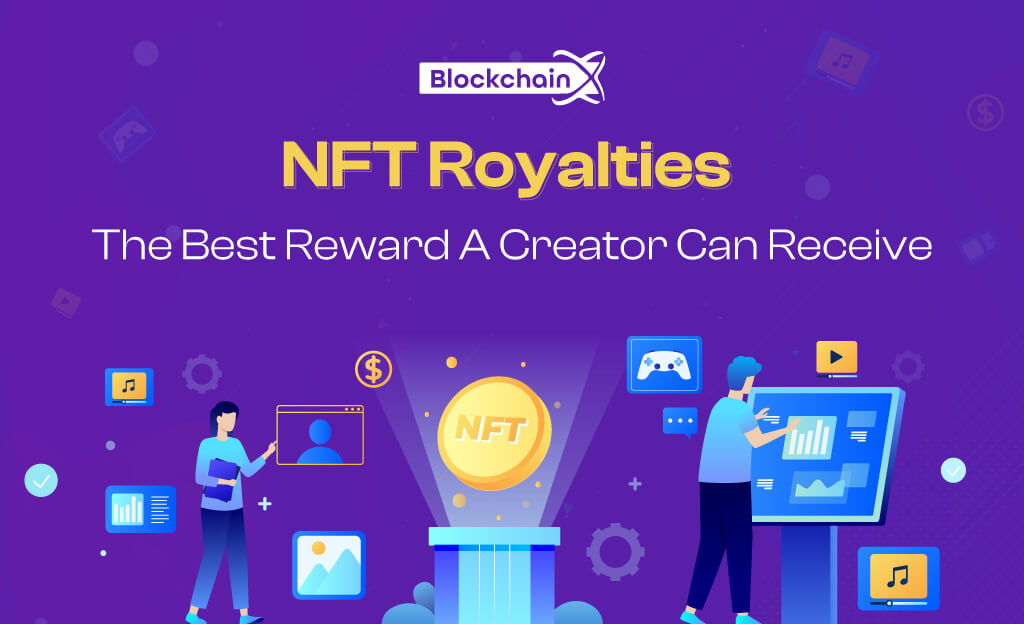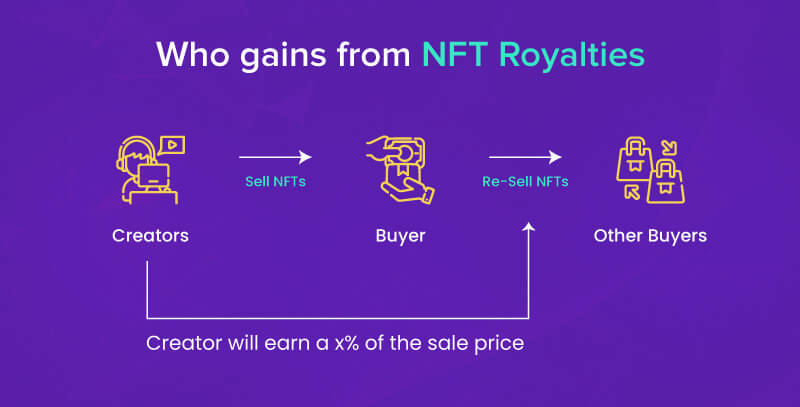
NFT Royalties: The Best Reward A Creator Can Receive
Royalties, we can refer to this as remuneration paid in cash or else one of the most important tools in the wider financial landscape. A royalty is money paid by one party to another party for using their assets.
Royalties from NFTs have introduced significant advantages to address the drawbacks associated with traditional royalty payment systems.
NFT owners can receive and maintain royalties for their creations. The following discussion will lead you to answer with an introduction about NFT royalties, their functions, and benefits.
NFT royalties are at the forefront of offering a long-term source of income to creators. This kind of feature allows creators to continue profiting from their NFTs
What are NFT Royalties?
NFT royalties give the actual owner a percentage of the sale price each time their works are resold on the secondary market. This is the same as in the music and film industries: to compensate creators for their work and provide a regular income stream.

NFT royalty percentages can vary from 0% to 10% in most markets, deducted from the seller's revenue in the secondary market.
Royalty payments are passive income a creator receives for each transaction of their sold product. The product can be music, art, game utilities, or any other form of digital asset. While creators earn from the initial sale of their NFTs, royalties are paid to the creator for each subsequent purchase, a double bonanza in short.
How Do NFT Royalties Work?
NFT royalties are rewards as money given automatically to the original NFT owner on secondary sales of the product. Royalties are tracked on the blockchain network. NFT royalties are selected by the NFT owner on a market or blockchain platform, during the mining process.
Royalties come from secondary sales, not first sales, or sales that occur in the marketplace after the original sale. To use a stock market analogy, this is similar to stock trading in the secondary market after being first sold in an initial public offering.
NFT royalties work through smart contracts that set a share of royalty payments from each secondary sale. The smart contract ensures the automation of royalty payments as prefixed rules are executed for each secondary sale of NFT and the collected information is stored on the blockchain.
The execution of the smart contracts verifies secondary sales and goes for a royalty check then receives a percentage of sales as royalty payment to be handed over to the creator.
NFT creators voluntarily choose a royalty percentage during mining, the process of making NFT content a part of the blockchain. It does this, and the required specifications are written using a smart contract, which is the existing programming on the blockchain. Once the blockchain's smart contract terms are created and executed, royalties automatically go to the original owner of the NFT.
Nifty royalty calculations are different in many ways, smart contracts are different according to marketplaces, or they are non-standard, so every royalty calculation is different. NFT royalties are calculated as a percentage of the selling price specified by the creator. If the royalty fee calculation has a residual effect, the royalty fee may be increased or decreased.
The selling price of the NFT may vary, but the royalty percentage of the NFT remains constant. Depending on market demand and scarcity, the amount of royalties the creator earns from each sale may vary. Thus, even though the royalty percentage remains the same, the creator can earn different royalty amounts from different sales.
Merits & Demerits of NFT Royalty
NFT royalties provide a way for creators to earn a continuous income from their creations even after they sell the NFTs to others. Therefore, the benefits of their NFTs won't be on-time. Then, every time the value of the NFTs increases will provide compensation for the creator as per the royalty, which helps the creator to earn more. For NFT royalties, the contract method is implemented in a smart contract without an intermediary, which gets triggered automatically once the NFT is sold. Royalties are automatically taken from the sale price of their NFT, making it easier to receive payment for their work.
Paying a high price for NFTs is sometimes a challenge for buyers as they have to pay royalties each time the NFT is resold. Some NFT marketplaces have made royalty payments optional, and some platforms are removing NFT royalties on their platforms. NFT markets are highly volatile. This will affect the frequency of NFT sales and the creator's royalty income. Hence, there is a huge change in the mindset of potential buyers to invest in NFTs. This will affect the sales volume.
Platforms that Support NFT Royalties
NFT royalties are still an emerging and new tech concept, but many platforms implement them to support creators. Some of the NFT marketplaces like "Blur" have made royalty payments optional; Whereas platforms like Looksrare have completely waived NFT royalties on their platform.
Rarible an aggregate NFT marketplace was established in 2020 to offer creators a user-friendly platform to showcase their artworks. The process of listing an artwork is simple, requiring users to create an account and connect a wallet. After that, you can upload works and adjust prices. Rareble charges a 1% fee for every transaction made on the platform, which is charged to both the buyer and the seller. Additionally, the Rarible platform allows creators to set royalties for their products.
Founded in 2017, OpenSea is currently the largest marketplace for NFTs. OpenSea announced a change to its fee structure this February, reducing its transaction fee from 2.5% to 0% for a limited time.
OpenSea also stated that the operator filter will not block marketplaces with the same policies. The optional creator provides times to income for all collections without on-chain enforcement. This change has had a meaningful impact on the NFT market, establishing OpenSea as an accessible and cost-effective platform for collectors and creators alike.
New to the industry but one of the biggest NFT marketplaces is Foundation, which launched in 2022. Foundation activities are more secure and standardized. If you want to list your digital art or collection on the Foundation, you need to wait for an invitation from an established community member who has sold at least 1 NFT. The Foundation platform collects a 5% fee on every sale, while the actual owner/creator is paid a 10% royalty and the seller receives the leftover 85%.
SuperRare is a leading NFT marketplace launched in 2018 that stands out from other NFT marketplaces by emphasizing the uniqueness of its digital artworks. Creators who wish to launch their NFTs on the SuperRare platform must first apply for approval from SuperRare Labs.
For SuperRare, the original owner receives a 10% royalty on each secondary sale, and the remaining 90% to the collector. And 3% is charged on each sale by the platform from the buyer.
Corruption was rampant when prices were falling due to macroeconomic conditions. Despite roadblocks, NFT royalties have a huge role in the revenue generation of the creator. It also helps in customer loyalty of organizations that promote buying and selling of collectibles. Creating a better brand experience by giving a portion of the revenue back to their customers. New concepts such as dynamic NFTs, which can alter or innovate the NFT's metadata, resulting in new characteristics for a subset of loyal users, fuel the attention and loyalty economy of NFTs within Web3.
In conclusion, NFT royalties have dramatically changed the art world, although a relatively new concept. The emergence of NFTs has provided creators with enabling them to pursue their craft, a reliable source of income. Additionally, it has opened up a new market for previously undervalued or neglected digital assets. As the use of NFTs increases, we can expect further transformations in artwork creation, sales, and valuation. Thus, NFTs not only revolutionize the art industry but have the potential to shape the future of creative expression.





